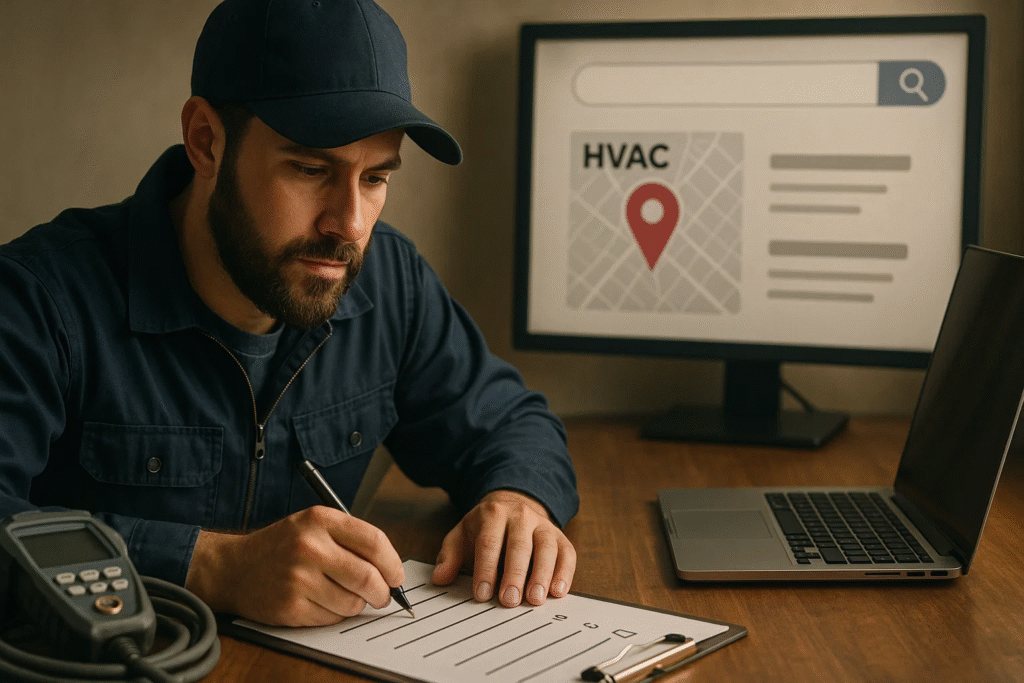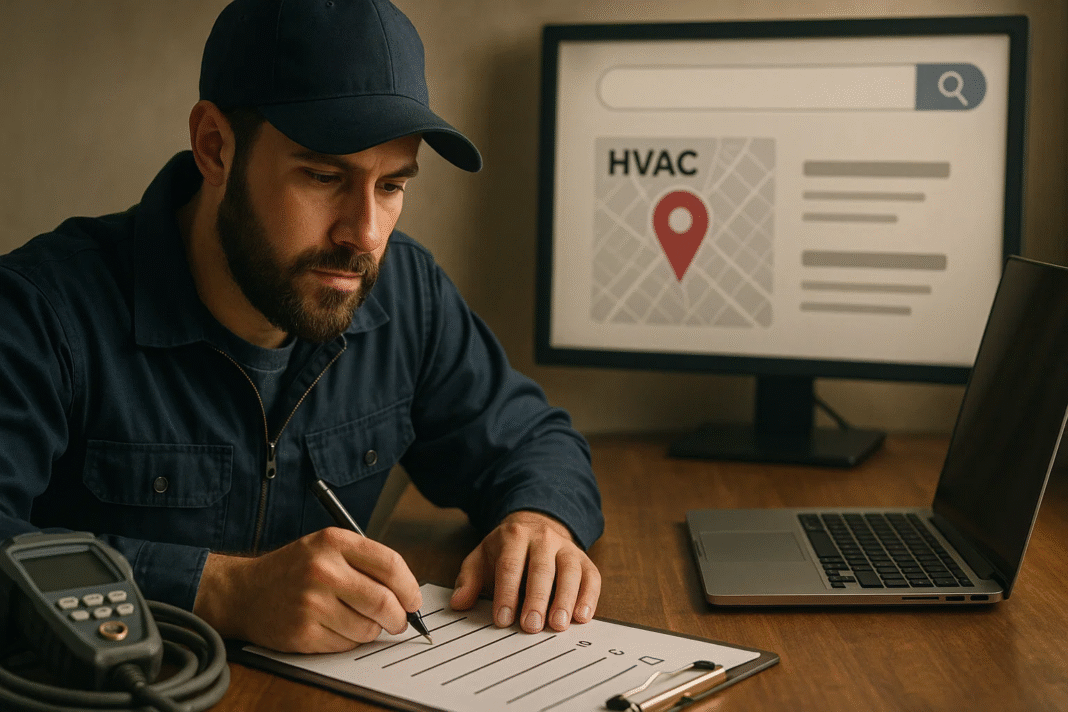Key Takeaways
- Optimizing your Google Business Profile is crucial for increasing HVAC visibility in local map packs and generating inbound leads.
- Local keyword targeting, citation building, and high-quality backlinks boost your website’s authority and search rankings.
- Creating valuable, geo-targeted content enhances user engagement and drives consistent traffic from nearby customers.
In today’s highly competitive digital landscape, local visibility is the lifeblood of HVAC businesses. Whether you’re a small heating and air conditioning service provider or a large-scale HVAC contractor, your success in 2025 hinges on one critical factor: being easily found by local customers when they search for HVAC services online.

Consumers are no longer turning to the Yellow Pages or word-of-mouth alone. Instead, they’re asking Google questions like:
- “Best HVAC company near me”
- “Emergency AC repair in [City]”
- “Furnace installation service in [Location]”
These searches are hyper-local and high-intent. And the businesses that appear at the top of local search results – especially in the Google Map Pack and organic top 3 positions – are winning the majority of clicks, calls, and conversions. This is exactly where HVAC Local SEO becomes indispensable.
Why Local SEO Matters More Than Ever for HVAC Businesses
Unlike broad, national SEO strategies, local SEO is laser-focused on optimizing your business to appear in search results for a specific geographic area. When executed correctly, a local SEO strategy can:
- Increase qualified website traffic from people in your city
- Drive inbound phone calls and quote requests from local homeowners and businesses
- Improve your visibility on Google Maps, Google Business Profile (GBP), and voice search
- Help you outperform competitors who are still relying solely on paid ads or outdated marketing tactics
In fact, studies show that over 78% of mobile local searches result in a purchase or service inquiry within 24 hours. And when it comes to HVAC, where urgency is often a key factor (e.g., a broken AC unit in the middle of a heatwave), the need to rank at the very top of local results is even more pressing.
The Problem: Most HVAC Companies Are Not Optimized Locally
Many HVAC business owners assume that having a website and some social media presence is enough. However, if your digital presence isn’t optimized for local search algorithms, you’ll likely be buried under competitors in the search results. Issues like inconsistent NAP (Name, Address, Phone), poor Google Business Profile optimization, and lack of local backlinks can prevent your business from appearing where it matters most — on the first page of Google.
In a digital age where customers choose from the top 3 search results, failing to show up there means missed opportunities, lost revenue, and declining local authority.
What You’ll Learn in This Guide
This in-depth blog post presents a proven HVAC Local SEO Checklist, outlining the Top 5 essential steps every HVAC company must take to rank #1 in their city. Whether you operate in a dense metro like Los Angeles or a smaller town like Springfield, these strategies are universally effective when implemented properly.
Each step in this guide is crafted to:
- Target Google’s local ranking signals
- Improve your online credibility and visibility
- Convert local searchers into loyal customers
The five steps include:
- Optimizing Your Google Business Profile (GBP)
- Local Keyword Optimization for Your Website
- Building High-Authority Local Citations
- Generating Quality Local Backlinks
- Creating Hyperlocal, Customer-Centric Content
We’ll also include practical examples, tools, charts, and matrices where relevant to help HVAC professionals — whether DIY marketers or business owners — execute each step with clarity and confidence.
Who Should Use This Checklist?
This guide is ideal for:
- HVAC contractors looking to expand their local market share
- Marketing managers in HVAC companies aiming to refine their local SEO game
- Local SEO agencies working with HVAC clients
- Startups or new HVAC businesses trying to gain traction in their service area
AppLabx: Your Trusted HVAC SEO Partner
If you prefer to focus on running your HVAC business while leaving the technical work to experts, partnering with a specialized HVAC SEO agency like AppLabx can accelerate your growth. AppLabx brings deep industry expertise, real-time local SEO tracking tools, and custom strategies tailored for the HVAC industry — helping you secure that coveted #1 spot in your city.
Get ready to elevate your local rankings, increase qualified leads, and future-proof your HVAC business for 2025 and beyond. Let’s dive into the step-by-step HVAC Local SEO Checklist that will help you dominate your local market.
HVAC Local SEO Checklist: Top 5 Steps to Rank #1 in Your City
- Optimize Your Google Business Profile (GBP)
- Local Keyword Optimization for Your Website
- Build High-Authority Local Citations
- Generate Local Backlinks for Authority
- Create Localized, Valuable Content
1. Optimize Your Google Business Profile (GBP)
An optimized Google Business Profile (formerly Google My Business) is the cornerstone of a successful HVAC local SEO strategy. It directly impacts your visibility in the Google Map Pack, which often appears above organic results and captures the majority of local search traffic. If your HVAC company is not optimized here, you’re likely invisible to most local customers who search for services like “AC repair near me” or “HVAC installation in [City]”.
1.1 Claim and Verify Your Google Business Profile
Why it matters
- Verifying your business ensures ownership and control over your profile.
- It allows you to update critical details like services, hours, service areas, and more.
Action Points
- Go to Google Business Profile Manager and search for your business.
- If it exists, claim it. If not, create a new listing.
- Complete verification by postcard, phone, or email (as offered by Google).
- Make sure your NAP (Name, Address, Phone) is consistent with your website and citations.
Example:
If your business name is “CoolTech HVAC Solutions”, don’t use variations like “Cool Tech HVAC” or “CoolTech Heating & Air” across other platforms. Consistency improves trust signals for Google.
1.2 Fill Out All Business Information Completely
Core Fields to Optimize
- Business Name: Use the official, legal name — avoid keyword stuffing.
- Categories:
- Primary: HVAC contractor
- Secondary: Air conditioning repair service, Furnace repair service, Heating equipment supplier, etc.
- Business Hours: Include holiday hours and special hours.
- Website URL: Point to your homepage or a local landing page.
- Services List:
- Add detailed HVAC services like “Ductless AC Installation”, “Heat Pump Repair”, etc.
- Business Description:
- Use 750 characters to describe your business, include city and service keywords naturally.
Sample Optimized Business Description
“CoolTech HVAC Solutions has been proudly serving the residents of Austin, TX since 2010, specializing in air conditioning installation, furnace repairs, heat pump maintenance, and 24/7 emergency HVAC services. We are certified, insured, and committed to energy-efficient HVAC solutions tailored to your home’s needs.”
1.3 Add High-Quality Photos and Videos
Why Visual Content Matters
- Profiles with images get 42% more direction requests and 35% more click-throughs to websites.
Must-Have Visuals
- Logo and cover photo
- Interior and exterior shots of your office or workshop
- Photos of your team at work, especially technicians in uniform
- Before-and-after project shots
- Short videos demonstrating service quality or behind-the-scenes work
Best Practice: Use geotagged images (tagged with your city location metadata) to strengthen local signals.
Recommended Image Types & Sizes Table
| Image Type | Dimensions (px) | Format | Notes |
|---|---|---|---|
| Logo | 720 x 720 | JPG/PNG | Clear and visible at small sizes |
| Cover Photo | 1024 x 576 | JPG/PNG | Represents brand or service area |
| Interior/Exterior Shots | 1200 x 900 | JPG/PNG | Well-lit and professional quality |
| Work-in-Progress Photos | 1200 x 900 | JPG/PNG | Showcase technical expertise |
| Videos | Max 75MB | MP4 | Under 30 seconds for best results |
1.4 Collect and Manage Customer Reviews
Why Reviews Are a Ranking Factor
- Google considers review quantity, velocity, and sentiment in local ranking.
- More positive, keyword-rich reviews increase trust and visibility.
How to Encourage Reviews
- Post-job follow-ups via SMS or email with direct review links.
- Add a “Leave us a review” CTA on your website and email signature.
- Provide incentives like monthly raffles (while complying with Google’s policies).
Respond to Every Review
- Thank customers for positive reviews.
- Address negative reviews professionally and resolve publicly when possible.
Review Management Matrix
| Review Type | Action | Example Response Template |
|---|---|---|
| Positive (5★) | Thank and mention specifics | “Thanks, John! We’re glad the AC installation in Plano met your expectations.” |
| Neutral (3★) | Ask for feedback & offer help | “Thanks for the review! Let us know how we can improve your experience.” |
| Negative (1–2★) | Acknowledge & resolve promptly | “We’re sorry to hear this. Please contact us directly at [Phone] so we can make things right.” |
1.5 Use GBP Posts and FAQs to Increase Engagement
Types of Posts to Use
- Promotional Offers: e.g., “15% off furnace maintenance this month”
- Service Updates: Announce new offerings or seasonal specials
- Events: Local home expos, community events
Best Practices
- Include a call to action (e.g., “Call Now”, “Book Today”)
- Use keywords naturally in post text
- Keep posts updated weekly to signal activity to Google
Use the FAQ Section to Answer Local Queries
- Examples of strategic FAQs:
- “Do you offer emergency HVAC repair in [City]?”
- “How soon can you install a new air conditioner in [Neighborhood]?”
FAQs increase your chances of showing up for voice searches and long-tail local keywords.
1.6 Track Performance with GBP Insights
Metrics to Monitor
- Search Queries: Keywords used to find your business
- Profile Views: Views on search vs. map
- Customer Actions:
- Website visits
- Direction requests
- Phone calls
- Photo Views: Compare your photos to similar businesses
Sample Monthly Insights Report Snapshot
| Metric | Your HVAC Business | Industry Average |
|---|---|---|
| Total Searches (Map + Web) | 5,300 | 4,100 |
| Website Clicks | 1,250 | 870 |
| Calls from GBP | 430 | 300 |
| Photo Views | 6,000 | 4,500 |
Conclusion: GBP Is the Foundation of HVAC Local SEO
An optimized Google Business Profile is not a “set-it-and-forget-it” asset. It’s a dynamic, high-value digital storefront that requires regular updates, community engagement, and strategic enhancements to remain competitive.
For HVAC companies that want to dominate local search results, Step 1 is non-negotiable. When implemented correctly, it not only increases your rankings but also improves customer trust and conversion rates dramatically.
If you’re unsure how to fully optimize your profile or track performance metrics consistently, AppLabx offers full-service HVAC SEO solutions, including GBP audits, review generation campaigns, and ongoing optimization to help you rank #1 in your city.
2. Local Keyword Optimization for Your Website
Local keyword optimization is a critical pillar in any successful HVAC local SEO strategy. It ensures that your website ranks prominently for high-intent, geo-targeted search terms used by potential customers in your city. Without the right keywords embedded across your site, your HVAC business is unlikely to appear in Google’s organic results or Map Pack listings, both of which are essential for visibility and conversion.
The goal of this step is to strategically identify and implement keywords that align with how local customers search for HVAC services, ensuring your content speaks directly to your audience and Google’s algorithms.
2.1 Perform In-Depth Local Keyword Research
Why Local Keyword Research Matters
- Identifies what services people are actively searching for in your area
- Helps tailor content to match local search demand
- Increases chances of ranking for high-converting, geo-specific queries
How to Conduct Local Keyword Research
- Use tools like Google Keyword Planner, Ahrefs, Ubersuggest, or BrightLocal.
- Search competitor websites to uncover high-performing keywords in your niche.
- Use autocomplete and “People Also Ask” features on Google for real-user insights.
Types of Local HVAC Keywords to Target
| Keyword Type | Example | Intent Level |
|---|---|---|
| Service + City | “furnace repair Austin” | High |
| Emergency HVAC Keywords | “24-hour AC repair in Miami” | Very High |
| Near-Me Searches | “HVAC contractor near me” | High |
| Long-Tail Local Keywords | “best HVAC service for condos in Denver” | Medium to High |
| Branded Local Terms | “CoolTech HVAC services Dallas” | Navigational |
2.2 Optimize Core On-Page Elements with Local Keywords
Page-Level Optimization Targets
- Focus on homepage, service pages, location pages, and contact page
Key Elements to Optimize
- Meta Title
- Example: “HVAC Repair & Installation Services in Chicago | CoolAir Experts”
- Meta Description
- Example: “Get top-rated HVAC repair, AC installation & furnace services in Chicago, IL. 24/7 emergency service. Licensed, insured, and local.”
- H1 Tags
- Clearly state service + city
- Example: “Reliable HVAC Services in Houston, TX”
- H2–H4 Subheadings
- Use service variations and neighborhood terms
- Example: “AC Maintenance for The Heights Neighborhood in Houston”
- Body Content
- Natural keyword integration 2–3 times per 300 words
- Mention local landmarks or customer neighborhoods
SEO Checklist Table: Local On-Page Optimization
| Element | Optimized Example | Notes |
|---|---|---|
| Title Tag | “Emergency HVAC Repair in Boston | AirFix Co.” |
| H1 Tag | “Professional AC Services in Boston, MA” | One per page, includes main keyword |
| Meta Description | “Trusted furnace and AC repair in Boston…” | Should be under 160 characters |
| URL Structure | “/boston-ac-repair” | Clean, short, and geo-targeted |
| Alt Text for Images | “technician repairing AC in Boston home” | Use descriptive, localized language |
| Internal Linking | “Explore our [heating services in Boston]” | Strengthens SEO equity site-wide |
2.3 Create City-Specific Landing Pages
Why Create Location Pages
- Helps target specific service areas beyond your physical office location
- Improves rankings for “service + city” queries
- Allows for hyper-personalized content that increases relevance
Best Practices for Local Pages
- Create one unique page for each city or neighborhood you serve
- Avoid duplicate content by customizing page text
- Include:
- City-specific headlines and subheadings
- Geo-targeted testimonials or case studies
- Embedded Google Maps of your service area
- Details about local regulations, weather-related HVAC issues, or local building codes
Sample Local Page Structure
| Page Section | Example Content |
|---|---|
| Hero Title | “AC Repair & Installation Services in Scottsdale, AZ” |
| Introduction | “Serving Scottsdale homeowners with expert HVAC solutions since 2008.” |
| Services in Area | “We provide AC tune-ups, ductless installations, and furnace repairs.” |
| Local Proof Points | “5-star reviews from Old Town and Gainey Ranch customers” |
| CTA | “Call now for same-day HVAC service in Scottsdale” |
2.4 Add Local Schema Markup for Rich Results
Why Schema Markup Matters
- Helps Google understand your business structure
- Increases chances of rich snippets, like ratings or business hours
- Boosts visibility in voice search and featured snippets
Types of Schema to Implement
- LocalBusiness
- Service
- Review
- FAQPage
Essential Local Schema Properties
@type: "HVACBusiness"name: "Your Company Name"address: { streetAddress, addressLocality, addressRegion, postalCode }telephoneareaServed: "City Name"
Use schema generators like Merkle Schema Markup Generator or add manually via JSON-LD
2.5 Use Geo-Targeted Internal and External Linking
Internal Linking Strategies
- Link from your homepage and service pages to each city page
- Use anchor text that includes both service and city
- Example: “Learn more about our [AC repair in Miami] services.”
External Linking Tips
- Get backlinks from local directories, Chambers of Commerce, and community blogs
- Link to local landmarks or events within content to strengthen geo-relevance
Geo-Anchor Text Strategy Matrix
| Page Type | Anchor Text Example | Link Destination |
|---|---|---|
| Homepage | “HVAC services in Plano, TX” | /plano-hvac-services |
| Service Page | “heating repair near Arlington Heights” | /arlington-heights-heating |
| Blog Post | “best HVAC systems for Chicago winters” | /chicago-hvac-winter-guide |
2.6 Monitor Keyword Performance and Adjust Accordingly
Tools to Use
- Google Search Console: Track impressions, clicks, and positions
- Ahrefs / SEMrush: Monitor keyword rankings and competitor performance
- BrightLocal: Local keyword tracking by city or zip code
Key Metrics to Track
- Local keyword rankings by city
- Click-through rates (CTR) on city-specific pages
- Pages with high bounce rates (content mismatch or poor UX)
- Pages generating conversions and phone calls
Keyword Performance Dashboard Example
| Keyword | Rank | Clicks | Impressions | Conversion Rate |
|---|---|---|---|---|
| “furnace repair Austin” | #2 | 310 | 1,400 | 18% |
| “24/7 HVAC Houston” | #1 | 270 | 1,050 | 21% |
| “AC tune-up in Scottsdale” | #3 | 190 | 980 | 16% |
| “HVAC company near me Miami” | #5 | 150 | 1,220 | 12% |
Conclusion: Local Keyword Optimization Is the Engine of HVAC Search Visibility
Optimizing your HVAC website for geo-targeted, service-based keywords is not a one-time effort — it’s a continuous, data-driven process that determines how often and where your business appears to potential customers. By conducting thorough keyword research, strategically integrating those terms across your site, and creating city-specific content supported by schema markup and proper linking, you create a strong, search-friendly foundation for dominating local results.
HVAC companies that want to secure lasting visibility in their city should treat keyword optimization as a high-impact, ongoing investment. If you need help conducting local keyword research, implementing schema, or optimizing dozens of city pages at scale, AppLabx offers HVAC-specific SEO packages to help you rank higher, faster, and convert more local leads than ever before.
3. Build High-Authority Local Citations
Local citations are any online mentions of your HVAC business’s Name, Address, and Phone Number (NAP) on external websites and directories. Building high-authority local citations is a fundamental component of HVAC local SEO, especially in 2025 when Google’s local ranking algorithms rely heavily on consistent, trustworthy business data across the web.
Citations help search engines validate your business’s legitimacy, relevance, and proximity to searchers. If you want to rank in Google’s Local Map Pack and increase local organic visibility, mastering citation building is a non-negotiable SEO priority for HVAC companies.
3.1 Understand the Role of Citations in Local SEO
Why Citations Matter
- Improve local search rankings by increasing trust and authority
- Reinforce your business’s geographical relevance
- Drive referral traffic from trusted platforms
- Increase brand exposure across search engines and local platforms
Types of Citations
| Citation Type | Definition | Example Platforms |
|---|---|---|
| Structured Citations | Listings with NAP details in a consistent format | Yelp, Angi, BBB, Yellow Pages |
| Unstructured Citations | Mentions within blog posts, news articles, or press releases | Local news sites, industry blogs |
3.2 Submit to Core General Business Directories
Must-Have Citation Sources
- These platforms have high domain authority and are trusted by Google.
- Ensure 100% NAP consistency when submitting.
| Platform | Domain Authority | Type | URL Format Example |
|---|---|---|---|
| Google Business Profile | 100 | Structured | business.google.com/profile |
| Bing Places | 90+ | Structured | bingplaces.com |
| Yelp | 93 | Structured | yelp.com/biz/hvac-company-city |
| Apple Maps | 80+ | Structured | maps.apple.com |
| 96 | Structured | facebook.com/yourhvacbiz | |
| YellowPages | 89 | Structured | yellowpages.com/hvac/your-city |
| Angi (Angie’s List) | 83 | Structured | angi.com/company/hvac-contractor |
Best Practice: Use the exact same business name, address, and phone number on every listing. Even small inconsistencies (e.g., “Street” vs. “St.”) can hurt your SEO trust score.
3.3 Build Citations on HVAC-Industry Specific Directories
Niche-Specific Citations for HVAC Businesses
- These platforms send strong topical signals to search engines
- They are highly relevant and often used by homeowners looking for HVAC services
| Directory | Type | Description |
|---|---|---|
| HomeAdvisor | Structured | Popular HVAC contractor listing platform |
| Thumbtack | Structured | Service marketplace with location-based filters |
| HVAC.com | Structured | HVAC-specific directory with business listings |
| ACCA Directory | Structured | For members of Air Conditioning Contractors of America |
| Angi | Structured | Dedicated HVAC and home improvement sections |
| BuildZoom | Structured | Profiles licensed HVAC pros with reviews & permits |
Example: A verified listing on HVAC.com with service areas listed as “Chicago, Naperville, and Schaumburg” can significantly strengthen your business’s keyword relevance for all three cities.
3.4 Submit to Local Business Directories in Your City
Hyperlocal Citation Sources
- Increase visibility for geo-targeted keywords
- Drive referral leads and help establish local relevance
| Local Directory Type | Example Platforms | Target |
|---|---|---|
| City Chamber of Commerce | yourcitychamber.org | B2B/B2C |
| Local News Outlets | yourcitytimes.com, localnewsnetwork.com | B2C |
| Neighborhood Associations | nextdoor.com/business | B2C |
| Local Business Hubs | patch.com/local/city | B2C |
Example: Submitting your business to the “Orlando Chamber of Commerce” website and mentioning “licensed AC repair in Winter Park and Downtown Orlando” boosts local relevance for those sub-regions.
3.5 Maintain Accurate and Consistent NAP Data
Common NAP Errors to Avoid
- Business name inconsistencies (e.g., “AirTech HVAC” vs. “Air Tech Heating & Cooling”)
- Using call tracking numbers inconsistently across listings
- Incorrect zip codes or outdated addresses
- Duplicate listings under the same or similar names
NAP Consistency Matrix Example
| Platform | Business Name | Address | Phone Number | Status |
|---|---|---|---|---|
| CoolTech HVAC | 123 Main St, Austin, TX 78701 | (512) 555-1243 | ✅ Correct | |
| Yelp | Cool Tech Heating & Air | 123 Main St, Austin, TX 78701 | (512) 555-1243 | ❌ Name Error |
| Angi | CoolTech HVAC | 123 Main Street, Austin, TX | (512) 555-1243 | ❌ Address Var |
| CoolTech HVAC | 123 Main St, Austin, TX 78701 | (512) 555-1243 | ✅ Correct |
Solution: Use tools like Yext, Moz Local, or BrightLocal to audit and fix inconsistencies.
3.6 Automate and Monitor Citations at Scale
Use Citation Management Tools
- Manage hundreds of listings across the web efficiently
- Detect errors, duplicates, and missing entries
- Sync real-time business data automatically
Top Citation Tools for HVAC SEO
| Tool | Features | Best For |
|---|---|---|
| BrightLocal | Citation tracking, audit, and building | Local SEO agencies & HVAC SMBs |
| Yext | Real-time sync across 50+ directories | Enterprise-level businesses |
| Whitespark | Manual citation building with human QA | Precision-focused local SEO |
| Moz Local | Citation audit and distribution | Cost-effective local optimization |
3.7 Track Citation Quality vs. Performance Impact
How to Evaluate Citation Value
- Not all citations are equal — focus on quality, relevance, and authority
Citation Quality Evaluation Matrix
| Platform | Domain Authority | Relevance | Traffic Volume | Conversion Potential | Score (/10) |
|---|---|---|---|---|---|
| Google Business | 100 | High | Very High | Very High | 10 |
| Yelp | 93 | Medium | High | High | 9 |
| HVAC.com | 72 | Very High | Moderate | High | 9.5 |
| City Directory | 60 | High | Low | Moderate | 7 |
| Blog Mention | 55 | Medium | Variable | Low–Moderate | 6 |
Focus your citation strategy on directories with scores of 7 and above for the best local SEO ROI.
3.8 Combine Citation Building with Review Generation
Boost Citation Value by Encouraging Reviews
- Listings with reviews rank higher and convert better
- Many citation sites double as review platforms
Platforms with Dual Citation + Review Features
- Google Business Profile
- Yelp
- Angi
- Thumbtack
Action Tip: After service completion, guide customers to leave a review on your citation listings, not just on Google.
Conclusion: High-Authority Citations Are the Backbone of HVAC Local Rankings
Building and maintaining a robust, consistent, and high-authority local citation profile is critical for HVAC companies aiming to rank #1 in their city. Citations amplify your digital presence, reinforce NAP consistency, and send strong location-based trust signals to Google’s local algorithm. More importantly, they place your business in front of homeowners actively searching for HVAC services across multiple platforms — not just Google.
If you’re managing citations manually or inconsistently, your local SEO performance is likely suffering. For HVAC businesses seeking full-scale citation building, cleanup, and automation, AppLabx offers citation services tailored to help you dominate local search and grow qualified leads in your service areas.
4. Generate Local Backlinks for Authority
One of the most critical yet often underutilized pillars of HVAC local SEO is local link building. Generating high-quality local backlinks boosts your website’s domain authority, builds trust with search engines, and strengthens your business’s association with specific geographic locations. For HVAC businesses aiming to rank #1 in their city, acquiring hyperlocal, relevant backlinks can make the difference between appearing in the Google Map Pack or being buried on page two.
Unlike generic backlinks, local backlinks signal both relevance and proximity to Google, two major ranking factors in local SEO algorithms. The goal is to earn backlinks from locally trusted domains that are relevant to your region, industry, or customer base.
4.1 Understand the SEO Power of Local Backlinks
Why Local Backlinks Matter
- Improve organic keyword rankings for city-specific search terms
- Strengthen local relevance in Google’s local algorithm
- Drive referral traffic from trusted, nearby sources
- Improve E-E-A-T (Experience, Expertise, Authority, Trust) for your website
Types of Local Backlinks
| Type | Description | Example Source |
|---|---|---|
| Geo-Local Backlinks | From websites based in your city or region | City newspaper, local blog, neighborhood portal |
| Industry-Local Backlinks | From HVAC-related sites with a regional focus | HVAC suppliers, state HVAC associations |
| Authority-Local Backlinks | From government, education, or media organizations | Local universities, .gov directories |
4.2 Partner with Local Organizations and Chambers
Build Links via Local Business Relationships
- Join your local Chamber of Commerce and request a website link
- Sponsor local events, expos, or home shows that offer link placement
- Collaborate with community development groups, local non-profits, or co-marketing partners
Example Backlink Sources
| Partner Type | Example Domain | Link Placement Opportunity |
|---|---|---|
| Chamber of Commerce | houstonchamber.org | Member directory with business profile |
| Local Home Expo Site | atlantahomeexpo.com | Exhibitor page with link to your website |
| Community Charity | buildbackhouston.org | Donor/sponsor listing page |
| HVAC Apprenticeship Org | ohiomechanicaltraining.com | Alumni/employer section |
Pro Tip: Offer to write or co-author an article about HVAC maintenance tips for the Chamber or local newsletter. This earns you an editorial backlink and thought leadership exposure.
4.3 Contribute to Local Blogs and News Publications
Guest Posting for Local SEO Authority
- Reach out to local real estate blogs, home improvement websites, or city lifestyle publications
- Offer to provide educational content on HVAC topics in exchange for a dofollow backlink
Content Ideas for Outreach
- “Top 5 Ways to Prepare Your AC for Dallas Summers”
- “HVAC Tips for Energy Efficiency in Chicago Homes”
- “How to Pick the Right Furnace Size for Your Home in Denver”
Outreach Email Template Matrix
| Component | Example Phrase |
|---|---|
| Subject Line | “Local HVAC Expert Offering a Guest Article for [Site]” |
| Pitch Hook | “I’d love to contribute a helpful guide for your readers about HVAC prep for the upcoming heatwave.” |
| Link Offer | “I’ll include a link to my service page only in the bio or as a relevant reference.” |
| Close | “Let me know if this sounds helpful – I can send over a few title ideas.” |
4.4 Sponsor Local Events, Schools, and Teams
Why Sponsorship Works
- Sponsoring local sports teams, school fundraisers, or charity events often includes a backlink from their websites
- It builds local goodwill while earning media mentions and citation links
High-Impact Sponsorship Opportunities
| Sponsorship Type | Example Source | Link Placement |
|---|---|---|
| High School Athletics | lincolnwolvesathletics.com | Sponsor list with logos/links |
| Local Fundraisers | runforcleanair.org | Sponsor landing page |
| Community Events | portlandhomefair.com | Exhibitor or sponsor sections |
Example: “CoolBreeze HVAC” sponsors a community home fair in Denver and gets a backlink from the event page that ranks for “home contractors in Denver.”
4.5 Publish Locally Focused Linkable Assets
What Are Linkable Assets?
- High-quality content or tools that local sites are inclined to link to because they’re helpful, unique, or timely
Examples of Local Linkable Content
- HVAC maintenance checklists tailored for your city’s climate
- Cost calculators for HVAC installations in local zip codes
- Interactive “When to Replace Your HVAC System” guides
- Blog posts featuring seasonal HVAC preparation tips for specific neighborhoods
Linkable Asset Matrix
| Content Type | Example Title | Local Tie-In |
|---|---|---|
| Downloadable PDF Guide | “Ultimate AC Maintenance Guide for Phoenix Homes” | Weather conditions in Phoenix |
| Interactive Tool | “Dallas HVAC Replacement Cost Calculator” | Zip-code specific estimates |
| Educational Blog Post | “Why Insulation Matters in New England Winters” | Region-specific advice |
| Infographic | “How Often Should You Change Air Filters in Miami?” | Humidity + HVAC workload explanation |
4.6 Earn Backlinks from Local Directories and Review Platforms
Dual Benefit: Citations + Links
- Submit to directories that offer dofollow links, not just NAP citations
- Encourage customers to leave reviews on these platforms
Top Platforms with Dofollow Local Links
| Platform | Dofollow Status | Anchor Type |
|---|---|---|
| Angi | Sometimes | Brand or service-based |
| Thumbtack | No | N/A |
| Houzz | Yes | Service/location combo |
| Nextdoor | Yes | Profile linking |
| BBB | Sometimes | Business name |
Tip: Use tools like Ahrefs or SEMrush Backlink Audit to confirm dofollow status before prioritizing submission.
4.7 Leverage Testimonials and Vendor Pages
Turn Vendor Relationships into Backlink Opportunities
- Provide testimonial quotes for HVAC equipment manufacturers, software platforms, or suppliers
- Ask to be listed on their “Clients” or “Partners” pages with a backlink
Example Vendor Link Sources
| Vendor Type | Example Company | Link Opportunity |
|---|---|---|
| Equipment Supplier | Trane, Carrier | “Trusted Contractors” page |
| HVAC Software | ServiceTitan, Housecall Pro | “Customer Success Stories” or “Testimonials” |
| Local Wholesalers | ABC Supply, Ferguson | “Preferred Contractors” section |
Sample Quote:
“We’ve been using Housecall Pro for over two years, and it’s transformed the way we manage HVAC jobs and dispatching in Tampa.”
4.8 Analyze Competitor Backlink Profiles
Reverse Engineer Local Link Strategies
- Use Ahrefs, Majestic, or SEMrush to audit backlinks of top HVAC competitors in your city
- Identify and replicate local publications, directories, or sponsors they’ve earned links from
Competitor Backlink Comparison Table
| Competitor | Referring Domains | Local Domains | High-Authority Local Links |
|---|---|---|---|
| HVACPro Chicago | 215 | 38 | chicagolandhvac.org, triblocal.com |
| AirMasters Austin | 180 | 42 | austinhomeexpo.com, kxan.com/business |
| Your Business | 92 | 12 | (Opportunity: Build 20+ local links) |
Prioritize replicating links with both high relevance and high authority in your service region.
Conclusion: Local Backlink Building = Trust + Visibility + Leads
Local backlinks remain one of the most powerful ranking factors in HVAC SEO. While many businesses focus only on citations and content, link building is what elevates your site above the competition, particularly in high-density service areas. Links from city-specific, niche-relevant, and trusted domains boost your HVAC business’s domain authority, Google trust score, and local map rankings — all of which convert into more phone calls, quote requests, and service bookings.
Because local link building requires outreach, negotiation, and strategic content development, it’s often neglected by competitors — making it an exceptional growth lever for HVAC businesses that get it right. For those seeking expert assistance in identifying, securing, and tracking high-value local links, AppLabx offers advanced HVAC SEO packages that include complete local link-building campaigns tailored to your service areas.
5. Create Localized, Valuable Content
In the competitive world of HVAC services, content is not just a marketing tool—it is a direct pipeline to local visibility, authority, and customer trust. Localized, valuable content serves as a beacon for both search engines and potential clients, establishing your HVAC brand as the go-to solution in your city or service area. Creating city-targeted, geo-specific, and intent-matching content ensures your business ranks higher in local search results and appears prominently in the Google Map Pack.
5.1 The Strategic Importance of Localized Content for HVAC SEO
Why Local Content Dominates in Local SEO
- Signals proximity and relevance to Google’s local algorithm
- Satisfies searcher intent with regional language and context
- Increases conversion rates by addressing specific neighborhood or climate challenges
- Boosts visibility for long-tail local search terms like “AC repair in East Austin”
Core Content Formats That Influence Local SEO
| Content Type | Purpose | Example Title |
|---|---|---|
| City-Specific Landing Page | Attract service queries by location | “HVAC Services in Orlando, FL” |
| Local Blog Article | Build authority, internal links, and keywords | “5 Signs Your AC Needs Repair in Houston” |
| Case Study | Demonstrate success and real-life impact | “How We Installed a Furnace in Chicago’s Loop” |
| Seasonal Guide | Address local weather needs and trends | “Winter Heating Prep for Boston Homes” |
5.2 Build SEO-Friendly Location Pages
Target Each Service Area With a Dedicated Page
- Create individual pages for every city, town, or neighborhood your HVAC business serves
- Ensure content is unique, not duplicated across locations
What to Include on a Location Page
- Localized headline and introduction mentioning the city
- Specific HVAC services offered in that area
- Google Map embed of your office or service radius
- Customer testimonials from residents of that location
- Schema markup with local business structured data
Location Page Structure Example
| Section | Content Element |
|---|---|
| H1 Heading | “HVAC Repair Services in Miami, FL” |
| Introductory Paragraph | “We provide fast and reliable AC repair in all of Miami…” |
| List of Services | AC installation, furnace repair, duct cleaning |
| Call-to-Action | “Call our Miami HVAC experts at (XXX) XXX-XXXX today” |
| Review Snippet | “Best HVAC company in Coral Gables!” – Sarah M. |
Tip: Add internal links to your service pages (e.g., “AC Maintenance”) and include outbound links to local landmarks (e.g., “near Miami Dade College”) to strengthen geo relevance.
5.3 Publish Blog Content With a Hyperlocal Focus
Create Blog Posts That Speak to Local Pain Points
- Address regional climate patterns, HVAC system stress, utility costs, and common repairs
- Answer local seasonal questions, such as “How to prepare your AC before Phoenix’s summer”
Examples of HVAC Blog Ideas With Geo-Intent
| Blog Title | Target City | Intent Covered |
|---|---|---|
| “Top HVAC Problems in Humid Climates Like Tampa” | Tampa, FL | Troubleshooting |
| “Best Thermostat Settings for Atlanta in Spring” | Atlanta, GA | Energy efficiency tips |
| “How to Winterize Your Heating System in Minneapolis” | Minneapolis, MN | Seasonal prep guide |
| “What Homeowners in Denver Need to Know About SEER Ratings” | Denver, CO | Buying advice |
Key SEO Elements for Local Blogs
- Use geo-modified keywords: e.g., “HVAC maintenance in Boise”
- Add internal links to related services and location pages
- Include FAQ schema markup for rich results
- Use image alt tags with local descriptors: “HVAC tech in San Diego neighborhood”
5.4 Leverage Local Testimonials and Case Studies as Content
Turn Customer Success Stories into Optimized Pages
- Write detailed case studies about specific projects completed in local neighborhoods
- Include:
- Customer background
- Problem description
- Solution provided
- Local challenges (e.g., zoning laws, old infrastructure)
- Photos or videos
- Direct quote/testimonial
Example Case Study Format
| Component | Example Content |
|---|---|
| Title | “How We Replaced a 20-Year-Old Furnace in Oakland Hills” |
| Challenge | Aging system causing high bills, inconsistent heating |
| Our Solution | Installed new high-efficiency furnace in 1 day |
| Local Obstacle | Permitting delays due to city holiday |
| Outcome | 35% energy savings in the first month |
| Testimonial | “Fast, professional, and knew the local codes well.” |
5.5 Incorporate Localized FAQs and Schema Markup
Add Value with Regional Q&A
- Answer questions that locals in your city actually ask
- Use Google’s People Also Ask (PAA) and Autocomplete as research sources
Sample Local FAQ Questions
| Question | Location |
|---|---|
| “What is the average cost of AC repair in Las Vegas?” | Las Vegas, NV |
| “How often should I service my HVAC in a humid climate?” | New Orleans, LA |
| “Does Boston require permits for furnace replacement?” | Boston, MA |
Implement FAQ Schema for Featured Snippets
- Use JSON-LD or microdata format to add schema to your FAQ sections
- This enhances your search result visibility and click-through rates
5.6 Create Local HVAC Service Guides and Checklists
Offer Downloadable or Shareable Tools
- HVAC checklists, pre-season guides, and installation prep PDFs
- Tailored to local weather and home types
Examples of Local Guide Content
| Title | Use Case | Target Market |
|---|---|---|
| “Summer AC Readiness Checklist for Orlando” | Preventive maintenance | Homeowners |
| “New HVAC System Buyer’s Guide for Chicago” | Installation decision support | New homebuyers |
| “Energy Savings Tips for Sacramento Winters” | Efficiency improvement | Eco-conscious users |
Tip: Add CTAs such as “Download your free checklist now” to capture leads.
5.7 Optimize for Voice Search and Mobile Local Queries
Target Conversational Search Patterns
- Use long-tail, natural language keywords that mimic how people talk
- Add city names into voice-friendly content like:
- “What’s the best AC unit for homes in Austin?”
- “Who installs HVAC systems near me in Seattle?”
Mobile-Friendly Formatting Checklist
| Mobile SEO Factor | Optimization Tips |
|---|---|
| Page Speed | Use compression, lazy loading, CDN |
| Font Size & Tap Targets | Ensure 16px font minimum, 44px tap areas |
| Clear CTAs | Buttons like “Call Now” or “Get Free Estimate” |
| Responsive Design | Fluid grids, media queries, scalable layout |
| Schema Markup | Add LocalBusiness, Service, and FAQ schema |
5.8 Use Content to Build Internal Link Structures
Create Silo Architecture Using Local Content
- Interlink location pages → service pages → blog posts
- This builds topical authority and ensures crawlers index your site deeply
Silo Structure Example
/services/
/services/air-conditioning/
/locations/houston/
/blog/top-ac-issues-in-houston/
/blog/prepare-houston-hvac-for-summer/
Each page strengthens the authority of the others, sending keyword signals up the chain and improving local SEO rankings.
Conclusion: Content that Connects, Converts, and Climbs Local Rankings
Creating localized, valuable content is a non-negotiable strategy for HVAC companies targeting the top of local search results. From tailored blog posts to geo-optimized service pages, region-specific FAQs, downloadable guides, and customer-centric case studies—every word you publish should deepen your brand’s connection with your target community. Not only does this content drive organic traffic, but it also increases dwell time, builds trust, and reinforces your local expertise.
Businesses that strategically develop this type of content outperform competitors relying solely on generic marketing copy. For HVAC companies aiming to scale lead generation through high-performance local SEO, AppLabx specializes in creating conversion-focused content that ranks in local packs, maps, and organic results—turning every city page or blog into a customer acquisition asset.
Conclusion
Bonus: Track Performance with Local SEO Tools
To succeed in local SEO for HVAC businesses, execution alone isn’t enough—measuring performance with the right tools is essential to optimizing ongoing efforts, identifying opportunities, and proving ROI. Tracking local SEO performance enables HVAC companies to understand how visible they are in their specific service areas, how users are interacting with their listings and content, and where they should refine or double down.
This section breaks down the best local SEO tracking tools, what key performance indicators (KPIs) to monitor, and how to create a repeatable tracking framework.
6.1 Why Tracking Local SEO Performance Is Crucial
Main Benefits of Local SEO Tracking
- Reveals what strategies are generating leads and revenue
- Helps identify visibility gaps in maps, organic, and mobile results
- Detects listing inconsistencies or spammy competitors
- Improves local content targeting by showing what ranks where
Common HVAC Business Use Cases
- Monitor Google Business Profile (GBP) rankings across ZIP codes
- Track organic keyword movements in a 5–15 mile radius
- Analyze competitor citation or backlink profiles
- Evaluate performance by device (desktop vs. mobile)
6.2 Top Tools to Track Local SEO Performance
Below is a comparison table of top-performing local SEO tools designed to help HVAC businesses measure and refine their strategies.
Tool Comparison Matrix
| Tool | Key Features | Best For | Pricing Range |
|---|---|---|---|
| BrightLocal | GBP audit, local rank tracking, citation monitoring, review mgmt | Local rank and listing accuracy | $39–$59/month |
| Whitespark | Citation tracking, local rank tracker, local audit tools | Citation and backlink tracking | Free & paid plans |
| Moz Local | Directory syncing, reputation management, listing monitoring | Automated listing distribution | $14–$33/month/location |
| Google Search Console | Keyword performance, coverage issues, mobile usability | Organic traffic insights | Free |
| GeoRanker | Heatmaps, local rankings from different zip codes, mobile checks | Geo-distributed SERP tracking | Custom plans |
| SEMrush (Local Pack) | Position tracking with local filters, listing management | Enterprise-level analysis | Starts at $129.95/mo |
| Local Falcon | Real-time local ranking heatmaps, multi-location tracking | GBP visibility in real time | Pay-per-scan model |
6.3 Critical Local SEO KPIs to Track
Monitoring the right metrics helps HVAC marketers focus efforts where it matters most. Below are the key local SEO metrics categorized by visibility, engagement, and conversion impact.
Visibility Metrics
- Local Pack Rankings (3-Pack)
- How often your HVAC business appears in the Google Map Pack
- Keyword Rankings (Geo-specific)
- Track rankings for keywords like “HVAC repair in [city]”
- Search Impressions in GBP
- Tracked inside Google Business Profile Insights
- SERP Coverage by ZIP Code
- Visualized using heatmaps from tools like Local Falcon or GeoRanker
Engagement Metrics
- Click-through Rate (CTR)
- From both GBP listings and organic listings
- Photo Views & Direction Requests
- Available from GBP dashboard
- Call-to-Action Engagements
- Button clicks like “Call Now”, “Visit Website” or “Get Directions”
Conversion Metrics
- Phone Calls from Listings
- Trackable via CallRail or GBP call log
- Form Submissions
- Use Google Tag Manager to fire events
- Appointment Bookings
- Use UTM tags + Google Analytics goal tracking
- Review Volume & Sentiment
- Measure quantity and quality of local reviews over time
6.4 Visualizing Local Performance with Heatmaps and Charts
Example: Local Falcon Heatmap Visualization
| Color Code | Meaning |
|---|---|
| Green | Ranks #1 locally |
| Yellow | Ranks #2–3 |
| Red | Not in the Top 3 Pack |
This spatial data allows HVAC businesses to:
- Identify strong-performing areas
- Detect “blind spots” where optimization is needed
- Visualize the impact of citation building or content updates over time
Example Chart: Local Pack Ranking Progression
Date | Rank for “HVAC Repair Tampa”
-------------|------------------------------
2025-05-01 | #5
2025-06-01 | #3
2025-07-01 | #1
Use this type of progression chart to correlate changes made (e.g., new blog, GMB updates) with ranking improvements.
6.5 How to Set Up a Local SEO Dashboard
Recommended Tools
- Google Looker Studio (formerly Data Studio)
- BrightLocal Dashboard
- Google Analytics 4
- Google Search Console
Dashboard Sections to Include
- Top Local Keywords
- Display changes in rankings and CTR
- Top Performing Locations
- Based on GBP views, clicks, or calls
- Traffic by Device and Geo
- Segment by desktop/mobile and ZIP code
- GBP Action Breakdown
- Calls, directions, website clicks
Sample Dashboard Layout
| Section | Metrics Displayed |
|---|---|
| Keyword Tracker | Top 10 search terms with rank changes |
| GBP Interaction Summary | Clicks, calls, directions in last 30 days |
| Geo Heatmap | Top ZIP codes by search volume |
| Review Performance | Review count, star rating, keyword frequency in reviews |
6.6 Example Monthly Performance Reporting Template
HVAC Local SEO Report Summary – July 2025
| KPI | Value | Change from June 2025 |
|---|---|---|
| GBP Views | 3,428 | +12% |
| GBP Phone Calls | 218 | +7% |
| Local Keyword Rankings Top 3 | 12/20 | +3 positions |
| Organic Search Clicks (Local) | 1,145 | +15% |
| Citations Added This Month | 35 | +20 new platforms |
| Local Backlinks Earned | 12 | +5 via sponsorships |
| Blog Traffic from “AC Repair Chicago” | 412 | +30% |
6.7 Automating Alerts and Ongoing Improvements
Use Automated Alerts To Track Key SEO Changes
- Google Alerts for brand or NAP changes
- BrightLocal Alert System for listing or review changes
- SEMrush Sensor to track local SERP volatility
Quarterly Optimization Checklist
- Audit local listings (NAP consistency)
- Review GBP insights for photo and post performance
- Update outdated location content
- Refresh review strategy (email follow-ups, SMS requests)
- Re-analyze citation gaps and competitors
Conclusion: Turn Data Into Direction with Local SEO Tools
Tracking HVAC local SEO performance using professional tools provides data-driven clarity, helping businesses make smarter decisions about how and where to invest their time and budget. By regularly analyzing rankings, engagement, and customer actions across platforms, HVAC companies can remain agile, outperform local competitors, and dominate their local markets.
Whether you’re managing one service area or multiple city hubs, leveraging platforms like BrightLocal, Whitespark, Google Search Console, and Local Falcon ensures that your HVAC business not only ranks—but also thrives—in local search. For HVAC companies looking to implement end-to-end tracking frameworks, AppLabx offers expert setup, monitoring, and optimization of performance dashboards to ensure measurable growth and sustained visibility.
Conclusion
Ranking #1 in your city’s local search results is no longer a luxury—it is a competitive necessity for HVAC companies looking to secure steady inbound leads, dominate their local markets, and build long-term brand equity. The journey to achieving local SEO success isn’t based on guesswork; it’s a structured, strategic process that involves mastering multiple technical and content-focused elements across your digital presence.
This comprehensive HVAC Local SEO Checklist has outlined the Top 5 essential steps to guide your business toward dominating your local area in Google’s map pack and organic search:
- Step 1: Optimize Your Google Business Profile (GBP)
- Step 2: Local Keyword Optimization for Your Website
- Step 3: Build High-Authority Local Citations
- Step 4: Generate Local Backlinks for Authority
- Step 5: Create Localized, Valuable Content
- Bonus: Track Performance with Local SEO Tools
Let’s recap the strategic value each step brings—and why they are critical to long-term HVAC marketing success.
Recap of Local SEO Action Plan
Step 1: Google Business Profile Optimization
- The foundation of your local visibility
- Ensures your HVAC business shows up in map listings with complete and engaging information
- Drives trust, conversions, and phone calls directly from Google Search and Maps
Step 2: Local Keyword Optimization
- Aligns your content with search intent across your city and neighborhoods
- Helps Google understand your service relevance to local queries
- Ensures both desktop and mobile visibility for high-converting keywords like “furnace repair near me”
Step 3: Local Citation Building
- Increases online visibility across top directories and platforms
- Enhances trust signals to search engines through consistent Name, Address, and Phone (NAP) data
- Expands your HVAC brand’s local digital footprint
Step 4: Local Link Building
- Establishes your authority within your community and niche
- Improves domain trust and local ranking through partnerships, sponsorships, and PR
- Connects your brand to real local relevance signals
Step 5: Valuable Local Content Creation
- Attracts and converts searchers with educational and service-focused resources
- Allows you to target specific geo-intent queries with blog posts, case studies, FAQs, and city pages
- Builds long-term SEO assets that improve over time
Bonus: Performance Tracking
- Equips your business with the data needed to refine and improve
- Allows real-time monitoring of local keyword movements, GBP actions, and lead flows
- Visualizes return on investment (ROI) with dashboards and SEO analytics tools
Long-Term Implications of Ignoring Local SEO
Failing to invest in local SEO means:
- Losing visibility to nearby competitors who dominate the map pack
- Missing out on high-converting, ready-to-buy customers who need HVAC services now
- Paying more for customer acquisition via ads while neglecting free organic leads
- Allowing your business’s credibility to erode in the eyes of search engines
The digital presence of HVAC companies is now deeply tied to location-based search, and Google continues to refine its algorithm to reward brands that demonstrate relevance, trust, and proximity.
Partner with Local SEO Experts for HVAC Growth
While this checklist empowers business owners and in-house marketers to begin the process, implementing these local SEO steps to their full potential often requires technical experience, strategic oversight, and executional efficiency.
This is where AppLabx stands out as the leading HVAC SEO agency. With deep expertise in local SEO strategies specifically tailored to HVAC companies, AppLabx offers:
- Full GBP optimization and review strategies
- Local keyword research and content development
- Citation audits and correction campaigns
- High-quality local backlink outreach
- Custom tracking dashboards for performance insights
Whether you operate in a small town or multiple metropolitan areas, partnering with local SEO professionals like AppLabx can dramatically reduce guesswork, accelerate ranking improvements, and turn your website and local listings into consistent lead-generation engines.
Final Thought: Dominate Your Local HVAC Market in 2025 and Beyond
The local HVAC industry is highly competitive, and consumer expectations are rising. Google is constantly evolving, but what remains consistent is its goal to serve users the most relevant, trusted, and nearby businesses.
By following this structured HVAC Local SEO Checklist—built on data, user intent, and local credibility—you can position your business at the top of local search results, outperform competitors, and attract the high-value customers searching for services in your city today.
Commit to these five pillars of local SEO, invest in consistent tracking and optimization, and you’ll establish long-term dominance in your service area—one city at a time.
If you are looking for a top-class digital marketer, then book a free consultation slot here.
If you find this article useful, why not share it with your friends and business partners, and also leave a nice comment below?
We, at the AppLabx Research Team, strive to bring the latest and most meaningful data, guides, and statistics to your doorstep.
To get access to top-quality guides, click over to the AppLabx Blog.
People also ask
What is HVAC local SEO and why is it important?
HVAC local SEO helps your business appear in local search results, driving more leads from customers in your service area.
How does Google Business Profile affect HVAC local SEO?
An optimized Google Business Profile boosts visibility in local searches and Google Maps, helping attract nearby customers.
What are the top ranking factors for HVAC local SEO?
Key factors include your GBP optimization, local keywords, NAP consistency, backlinks, reviews, and location-relevant content.
How do I optimize my HVAC Google Business Profile?
Complete your profile, use accurate categories, upload photos, gather reviews, and regularly update business information.
Which keywords should I target for HVAC local SEO?
Target location-based service keywords like “AC repair [city]” or “HVAC contractor near me” for better local visibility.
What are local citations and why do they matter?
Local citations are mentions of your business on directories like Yelp and Angi. They help build trust and improve rankings.
How can I check if my citations are consistent?
Use tools like Moz Local, BrightLocal, or Whitespark to audit and manage your citation consistency across directories.
What makes a good HVAC local backlink?
A good local backlink comes from a trusted, locally relevant site such as a chamber of commerce, local news site, or sponsor.
How do I get local backlinks for my HVAC business?
Reach out to local blogs, sponsor community events, get listed in directories, and collaborate with other local businesses.
Why is localized content important for HVAC SEO?
Localized content targets specific cities and neighborhoods, making your website more relevant to local searchers.
What type of content should HVAC companies create?
Write city-specific service pages, how-to guides, seasonal tips, local project case studies, and HVAC maintenance blogs.
How often should I update my Google Business Profile?
Update it at least monthly or whenever your hours, services, or promotions change to keep it fresh and relevant.
What’s the best way to collect local reviews?
Ask happy customers directly, send follow-up emails, and use review generation tools integrated with your CRM.
Does responding to reviews help HVAC SEO?
Yes, engaging with customer reviews signals to Google that your business is active and customer-focused.
How long does it take to see results from HVAC local SEO?
Typically, you can start seeing improvements in 3–6 months, depending on competition and how consistently you apply SEO.
Can social media impact my local SEO rankings?
While social media doesn’t directly affect rankings, it helps boost brand awareness and can drive local traffic to your site.
What are common mistakes in HVAC local SEO?
Ignoring GBP optimization, inconsistent NAP data, missing local keywords, and not building local backlinks are major issues.
Is blogging necessary for HVAC local SEO?
Yes, blogging helps target long-tail and local search queries while establishing authority and trust in your market.
Should I have separate pages for each service location?
Yes, create city-specific landing pages to better target searches in different service areas and improve local relevance.
How do I measure local SEO performance for my HVAC business?
Use tools like Google Search Console, Google Analytics, and local rank trackers to monitor keyword rankings and traffic.
Which tools help manage HVAC local SEO efficiently?
Top tools include BrightLocal, Moz Local, Semrush, Ahrefs, Whitespark, and Google Business Profile Insights.
Can paid ads help my HVAC SEO?
Paid ads don’t directly affect SEO rankings, but they can drive traffic and support brand awareness in competitive markets.
Is mobile optimization important for HVAC SEO?
Absolutely. Most local searches happen on mobile devices, so your website must be fast, mobile-friendly, and responsive.
How many local citations should an HVAC business have?
Aim for 50–100 high-quality, consistent citations across top directories, niche sites, and local business platforms.
Does schema markup help with local SEO?
Yes, local business schema helps search engines better understand your business info, improving rich results and visibility.
How does proximity affect HVAC local SEO rankings?
Google prioritizes results based on how close your business is to the searcher’s location, especially in the map pack.
What is the local map pack and how do I rank in it?
The local map pack shows the top 3 nearby businesses in search results. To rank, focus on GBP optimization and reviews.
Can negative reviews hurt my HVAC local SEO?
Too many negative reviews can affect trust and click-throughs. Respond professionally and resolve issues when possible.
Do directory listings still matter for HVAC SEO?
Yes, being listed in trusted directories with consistent NAP data strengthens your business’s authority and local presence.
Why should I work with a local SEO agency for HVAC?
A specialized agency understands HVAC-specific strategies and local market dynamics, helping accelerate SEO results.


































